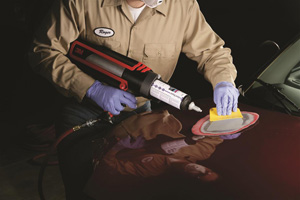
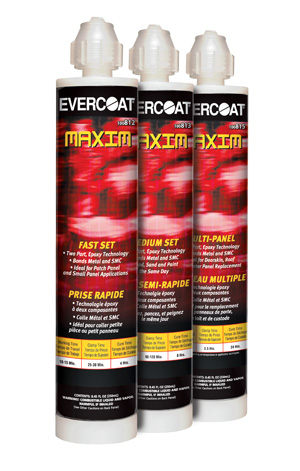
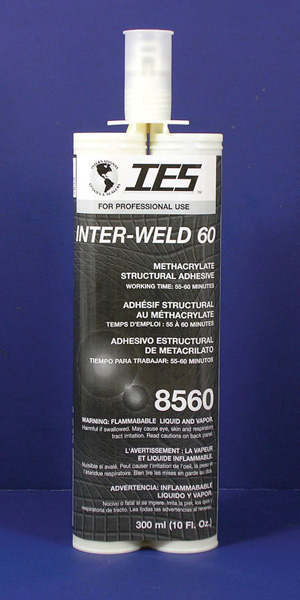
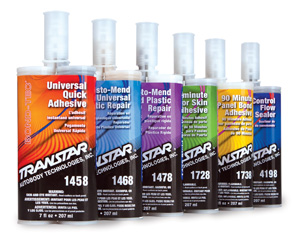
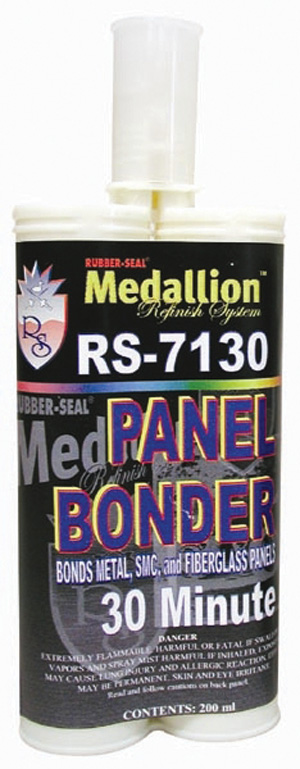 Adhesives can save a shop technician a lot of time and allow the shop to offer customers a smoother repair. They work well on small parts and turn out well on large panels, including roof panels. Most shops marry adhesives and welds to get the job done. Yet there are several other factors that need to be considered when squeezing out the cartridge or applying the first coat.
Adhesives can save a shop technician a lot of time and allow the shop to offer customers a smoother repair. They work well on small parts and turn out well on large panels, including roof panels. Most shops marry adhesives and welds to get the job done. Yet there are several other factors that need to be considered when squeezing out the cartridge or applying the first coat.
Starting Out
“Make sure the adhesive is designed for the job at hand,” says David McCullough, president of Catalyst Industries, Inc. and Catalyst Direct, Coeur d’Alene, Idaho. It sounds basic but is based in reality. “There are many variables here such as type of substrate, strength required, curing time, etc.”
Says Julie Montes, director of marketing for Transtar Autobody Technologies, Inc., Brighton, Mich., “A repairer should look for an adhesive that meets the repair. In the case of metal bonding, for instance, important factors such as meeting OEM specifications, carrying a lifetime warranty and being able to accelerate cure time with heat are important product benefits.”
On top of that, says Jerry Zingerman, national sales manager of International Epoxies and Sealers, San Antonio, Fla., follow the instructions. He sees too many cases where a technician will pick up cartridge A from one manufacturer, take cartridge B from another manufacturer and not read the instructions on either – but use it the way he had success with manufacturer C’s adhesive. Bad idea.
“Read the directions from whatever product you’re using,” Zingerman says.
“Look for adhesives that can bond the largest variety of substrates with the least number of products,” advises Jim Testa, product manager at Evercoat. On his shopping list would be materials with a work time that meets the needs of a shop’s commonly done repairs, products that meet or exceed the OEM specifications for bonding strength, ones that are easy-to-use and that have clamp times that allow for same-day repairs when needed.
What constitutes “easy to use?” Testa says shops should favor materials that have low odor, are easy to gun and easy to apply.
“Time to cure is a very important consideration in a production shop,” Catalyst’s McCullough says. “I personally would rate it as most important next to the integrity of the bond.”
While most experts agree that time to cure and integrity are both important factors, Steven J. Widen, U.S marketing supervisor in 3M’s Automotive Aftermarket Division, notes that it depends on the application of the adhesives the shop will be using.
Remember, however, that fastest isn’t always best. A material used on small areas probably should have a fast set-up time. However, a technician will appreciate the extra few minutes if working on a larger area like a roof or quarter panel.
Expanding on that idea, Randy Schneider, marketing, applications and technical specialist for Medallion Refinish System, Dayton, Ohio, advises, “Choose a product with the proper work time. Choose a product that meets the specs of a bonding adhesive and is a true bonding adhesive.”
Evercoat’s Testa downplays time to cure as not being the most the important factor next to integrity of the bond. “Time to cure can be accelerated with heat,” he points out.
On top of that, 3M’s Widen says, “Adhesives are a much faster repair and cleaner.”
“These products add to productivity in the collision shop with their ease of use,” he continues, noting that the ability of many adhesives to be heat cured also contributes to productivity.
International’s Zingerman would add de-clamping time as a primary consideration when choosing an adhesive. On some jobs, the time with a panel bond can be 1.5 to 2.5 hours. With others, it’s 4 hours. “If you think about technician productivity, this is important,” Zingerman says.
Where Products Fit
Because of their ease-of-use, many technicians tend to opt for using adhesives over welds. Evercoat’s Testa says he always recommends that technicians follow OEM recommendations for panel bonding. Checking those OEM recommendations and procedures for panel bonding is the first thing a tech should do.
Transtar’s Montes also stresses the importance of OEM guidelines. “It’s crucial that repairers read and adhere to OEM recommendations for structural repairs. Some have recommendations for weld bonding or bonding panel to panel without welding (i.e. glue with no welding).”
3M’s Widen emphasizes that techs need to make sure that they’re using the correct adhesives for the repair orders they’re working on.
When scoping out a job, the tech needs to consider the work time needed to align, bond and clamp the panel within the working time of his adhesive. “Finally, the tech needs to follow the adhesive manufacturer’s recommendation for minimum temperature of adhesive and substrate,” Evercoat’s Testa says.
The Catalyst Industries product is designed mainly for interior panel tabs, headlight bezel tabs, grill tabs, etc., that break when a tech is trying to R&I. “It’s simple to use, cures in four seconds, and the Rapid Fill powder in the kit allows for reinforcing the repaired joint so that it won’t break again,” McCullough says. That Rapid Fill powder also allows the user to make missing pieces by making a mold from clay or Play Dough or using various other techniques.
Even the new substrates – high-strength steel, martensite, aluminum, boron – are candidates for adhesive bonding. “To the best of my knowledge, methylmethacrolates (MMA), epoxies or urethanes will adhere to all of these substrates,” Medallion’s Schneider says.
“This is a great area to use 3M Panel Bonding Adhesive,” Widen says. “A lot of OEMs are producing vehicles that are bonded at
the OEM.”
Techs or shop managers who are concerned about the strength of an adhesive should check out www.alldata.com, www.verifactsauto.com or www.oem1stop.com. These websites provide good metrics on adhesives and welds and also offer OEM panel bonding specifications.
“We feel that bonding is a much stronger repair,” Widen says, “but we do recommend that the collision shop go by the OEM recommendation. The 3M perspective is to always bond a structural component of the vehicle.”
Making It Work
No adhesive job should be without welds, at least no job that involves larger panels. Years ago, some adhesive manufacturers touted glues that didn’t require welds. For the most part, that’s history. “Adhesives are flexible and strong but not strong enough to stand alone,” Zingerman says.
“Most companies follow the same instructions to have two plug welds in each corner of a roof panel,” Zingerman says. On a long roof, say an extended van, it pays to put a couple in the middle of each side. “On a curve, the body of the vehicle will have a good twist, and that center weld is added insurance,” he explains.
The same holds with pickup truck bodies. It’s a good idea to put a couple of welds where the floor meets the inner fender. You can just bet that someone will drop a pallet of fertilizer bags or roll a 55-gallon drum onto the back and an adhesive-only weld might break. “Go ahead and glue along the rail but add welds,” Zingerman advises.
That comes back to Widen’s advice to all shops: be aware of what type of repair adhesives you need for the correct application. “There are a lot of adhesives and it can be confusing, so using the correct adhesives is a must,” Widen says.
“When using adhesives, the main thing a tech should be thinking about is if it will put the vehicle back to, or better than, factory specs,” McCullough says. He emphasizes that the tech should be especially aware of the vehicle’s structural integrity so that it’s safe: “Cost should have little consideration.”
“The repair should be brought back to pre-accident condition,” Schneider says. “If the OEM panel is installed with adhesive, then the repair should be done with bonding adhesives. If the factory used a weld application, then the repair should be welded. In some cases, panels are installed at the factory using a combination of bonding adhesive and weld.”
“Panel preparation is one of most important steps in bonding and is the cause of most failures,” Schneider continues.
Transtar’s Montes agrees. “Without the proper prepping of the surface, such as sanding, grinding, cleaning and applying metal prep if required, the material will not adhere to the substrate.”
Zingerman cautions against using adhesives on frame rails since the bond can be too strong and the car won’t crumple where it should.
“Welding should be done just prior to declamping,” Zingerman says. Be careful of igniting the glue. When dealing with materials like acrylics, remember they’re quite flammable when wet. “When it’s set, then do your welding and then declamp,” he says.
Whichever product you choose for your shop, Zingerman says that the manufacturer will usually have the highest quality material available at the best price.
“Purchase from a reputable company with tech support,” agrees Schneider. Beyond that, he would consider the working times of the adhesives and make sure the panel bonders contain glass bead-product specifications.
“Choose a bonding adhesive that gives you plenty of work time for the particular application,” he concludes.
Download a chart outlining different adhesives on the market
Curt Harler is a Cleveland-based freelance writer specializing in the automotive, technology and environmental areas. He’s the recipient of the International Communications Association Industry Achievement award for his writing. You can reach him at [email protected].













